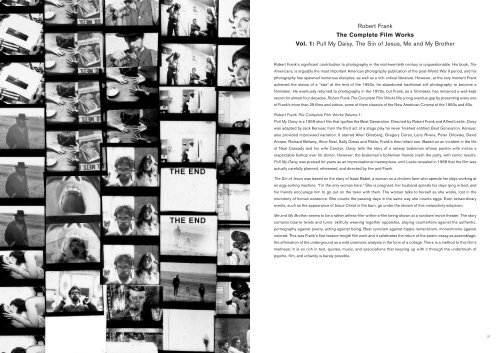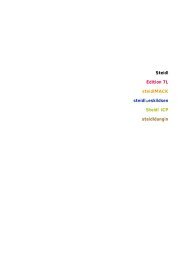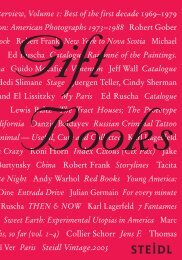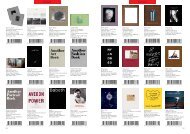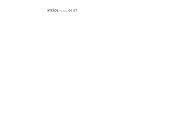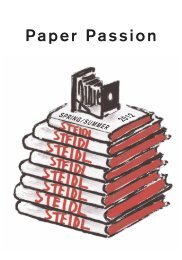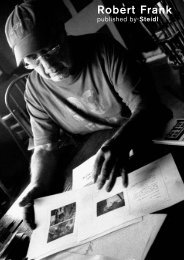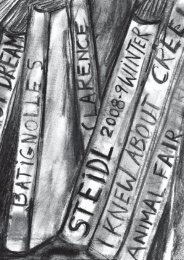Germany. The home of the Swedish photobook. Greger Ulf ... - Steidl
Germany. The home of the Swedish photobook. Greger Ulf ... - Steidl
Germany. The home of the Swedish photobook. Greger Ulf ... - Steidl
You also want an ePaper? Increase the reach of your titles
YUMPU automatically turns print PDFs into web optimized ePapers that Google loves.
Robert Frank<br />
<strong>The</strong> Complete Film Works<br />
Vol. 1: Pull My Daisy, <strong>The</strong> Sin <strong>of</strong> Jesus, Me and My Bro<strong>the</strong>r<br />
Robert Frank’s significant contribution to photography in <strong>the</strong> mid-twentieth century is unquestionable. His book, <strong>The</strong><br />
Americans, is arguably <strong>the</strong> most important American photography publication <strong>of</strong> <strong>the</strong> post-World War II period, and his<br />
photography has spawned numerous disciples, as well as a rich critical literature. However, at <strong>the</strong> very moment Frank<br />
achieved <strong>the</strong> status <strong>of</strong> a “star” at <strong>the</strong> end <strong>of</strong> <strong>the</strong> 1950s, he abandoned traditional still photography to become a<br />
filmmaker. He eventually returned to photography in <strong>the</strong> 1970s, but Frank, as a filmmaker, has remained a well-kept<br />
secret for almost four decades. Robert Frank <strong>The</strong> Complete Film Works fills a long overdue gap by presenting every one<br />
<strong>of</strong> Frank's more than 25 films and videos, some <strong>of</strong> <strong>the</strong>m classics <strong>of</strong> <strong>the</strong> New American Cinema <strong>of</strong> <strong>the</strong> 1950s and 60s.<br />
Robert Frank <strong>The</strong> Complete Film Works Volume 1:<br />
Pull My Daisy is a 1959 short film that typifies <strong>the</strong> Beat Generation. Directed by Robert Frank and Alfred Leslie, Daisy<br />
was adapted by Jack Kerouac from <strong>the</strong> third act <strong>of</strong> a stage play he never finished entitled Beat Generation. Kerouac<br />
also provided improvised narration. It starred Allen Ginsberg, Gregory Corso, Larry Rivers, Peter Orlovsky, David<br />
Amram, Richard Bellamy, Alice Neel, Sally Gross and Pablo, Frank’s <strong>the</strong>n-infant son. Based on an incident in <strong>the</strong> life<br />
<strong>of</strong> Neal Cassady and his wife Carolyn, Daisy tells <strong>the</strong> story <strong>of</strong> a railway brakeman whose painter wife invites a<br />
respectable bishop over for dinner. However, <strong>the</strong> brakeman’s bohemian friends crash <strong>the</strong> party, with comic results.<br />
Pull My Daisy was praised for years as an improvisational masterpiece, until Leslie revealed in 1968 that <strong>the</strong> film was<br />
actually carefully planned, rehearsed, and directed by him and Frank.<br />
<strong>The</strong> Sin <strong>of</strong> Jesus was based on <strong>the</strong> story <strong>of</strong> Isaac Babel, a woman on a chicken farm who spends her days working at<br />
an egg-sorting machine. “I’m <strong>the</strong> only woman here.” She is pregnant, her husband spends his days lying in bed, and<br />
his friends encourage him to go out on <strong>the</strong> town with <strong>the</strong>m. <strong>The</strong> woman talks to herself as she works, lost in <strong>the</strong><br />
monotony <strong>of</strong> human existence. She counts <strong>the</strong> passing days in <strong>the</strong> same way she counts eggs. Even extraordinary<br />
events, such as <strong>the</strong> appearance <strong>of</strong> Jesus Christ in <strong>the</strong> barn, go under <strong>the</strong> stream <strong>of</strong> this melancholy solipsism.<br />
Me and My Bro<strong>the</strong>r seems to be a ra<strong>the</strong>r artless-film-within-a-film being shown at a rundown movie <strong>the</strong>ater. <strong>The</strong> story<br />
contains bizarre twists and turns: skillfully weaving toge<strong>the</strong>r opposites, playing counterfeits against <strong>the</strong> au<strong>the</strong>ntic,<br />
pornography against poetry, acting against being, Beat cynicism against hippie romanticism, monochrome against<br />
colored. This was Frank’s first feature-length film work and it celebrates <strong>the</strong> return <strong>of</strong> <strong>the</strong> poetic essay as assemblage,<br />
<strong>the</strong> affirmation <strong>of</strong> <strong>the</strong> underground as a wild cinematic analysis in <strong>the</strong> form <strong>of</strong> a collage. <strong>The</strong>re is a method to this film’s<br />
madness: It is so rich in text, quotes, music, and associations that keeping up with it through <strong>the</strong> underbrush <strong>of</strong><br />
psyche, film, and urbanity is barely possible.<br />
36 37


